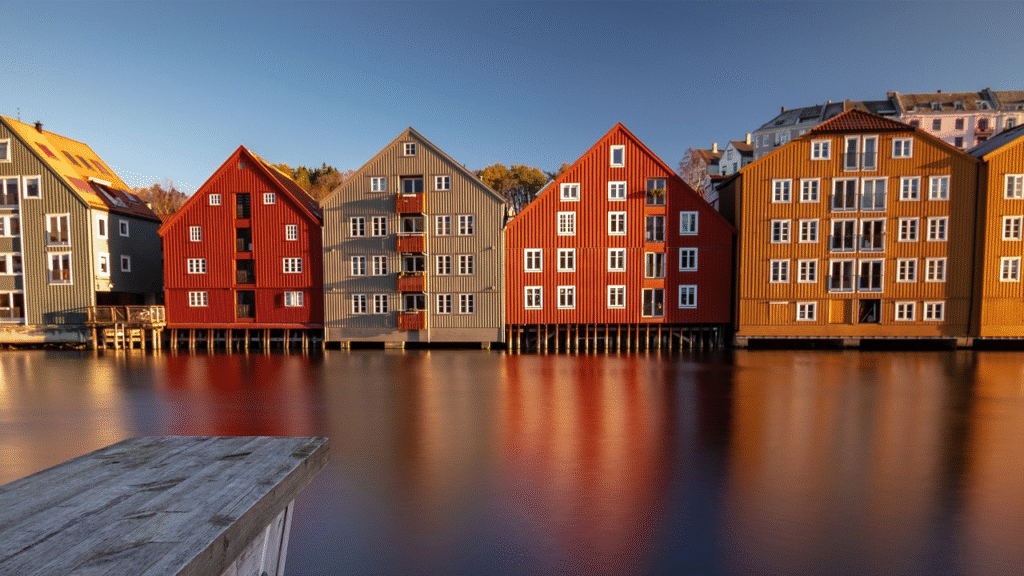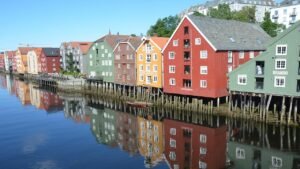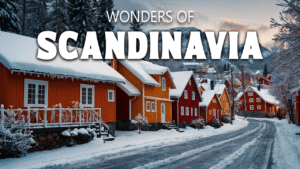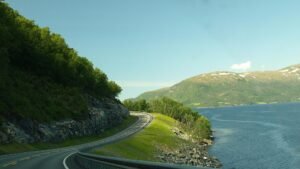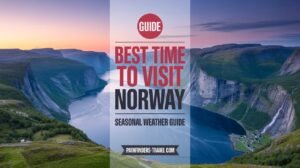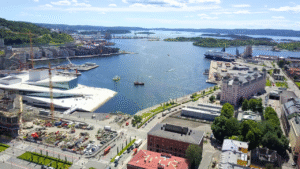Estimated reading time: 18 minutes
Key Takeaways
- Norway offers a perfect blend of urban exploration and natural landscapes, from vibrant cities to majestic fjords.
- Oslo combines modern architecture with Viking history, featuring attractions like the Opera House and Vigeland Sculpture Park.
- Bergen serves as the gateway to fjords, with its UNESCO-listed Bryggen Wharf and access to spectacular natural scenery.
- Northern Norway presents Arctic adventures like witnessing the Northern Lights in Tromsø and exploring the remote wilderness of Svalbard.
- Seasonal considerations are important—summer brings midnight sun and hiking opportunities, while winter offers Northern Lights and snow activities.
Table of Contents
- Introduction
- Oslo: The Modern Capital with Viking Roots
- The Allure of Coastal Charm: Drøbak and Kristiansand
- Stavanger and Odda/Trolltunga: Adventure and History Combined
- Bergen: Gateway to Norway’s Fjords
- Exploring Majestic Fjords and Natural Landscapes
- Northern Norway: Wonders of the Arctic
- Conclusion and Practical Travel Tips
Introduction
Norway stands as one of the world’s most captivating travel destinations, offering an extraordinary mix of vibrant cities, rich cultural heritage, and awe-inspiring landscapes. For travelers wondering about the best cities in Norway to visit, this guide provides a comprehensive overview to help you decide where to go in Norway for your next adventure.
What makes Norway truly special is its unique combination of urban sophistication and untamed wilderness. From the moment you arrive, you’ll be struck by how seamlessly Viking history blends with cutting-edge architecture, and how quickly you can travel from a bustling city center to standing at the edge of a dramatic fjord or mountain plateau.
As we journey through the top Norway travel destinations, you’ll discover cities where ancient traditions thrive alongside innovation, coastal towns with maritime heritage, and natural wonders that will take your breath away. Whether you’re drawn to cultural experiences, outdoor adventures, or simply want to witness some of the most spectacular scenery on Earth, Norway offers it all in abundance.
Want to see this for yourself? Click here to watch the video from this point.
Oslo: The Modern Capital with Viking Roots

Any Oslo travel guide will tell you that Norway’s capital perfectly showcases the country’s ability to honor its past while boldly stepping into the future. This vibrant city offers visitors a fascinating mix of modern innovation and Viking heritage that makes it an essential stop on any Norwegian itinerary.
The Oslo Opera House stands as a testament to the city’s architectural vision, with its striking design that appears to rise directly from the waters of the Oslo Fjord. Visitors can actually walk on the roof of this marble and glass masterpiece for panoramic views of the city and waterfront. Just beside it, the recently rebuilt Munch Museum (reopened in October 2021) houses the world’s largest collection of works by Norway’s most famous painter, Edvard Munch, including several versions of his iconic painting “The Scream.”
For those interested in Viking history, Oslo offers fascinating insights into this crucial period. While the renowned Viking Ship Museum is closed for renovations until 2027, the Historical Museum currently showcases essential Viking artifacts in its Víkingr exhibition, providing new context for understanding Oslo’s ancient roots. [SOURCE]
No visit to Oslo would be complete without exploring the Vigeland Sculpture Park, an open-air museum featuring over 200 sculptures by Gustav Vigeland. This unique cultural space provides a serene escape within the city, with artworks that reflect on the beauty and complexity of human life.
High above the city, the famous Holmenkollen Ski Jump stands as a monument to Norway’s love of winter sports. This historic site, which has hosted Olympic events, offers both breathtaking views and houses the world’s oldest ski museum, making it a must-visit for sports enthusiasts and history buffs alike.
Oslo’s vibrant neighborhoods like Aker Brygge provide waterfront dining, shopping, and entertainment, while the city’s numerous museums, galleries, and parks offer endless opportunities for cultural exploration. With its efficient public transportation system, Oslo makes it easy to experience everything from historic sites to natural areas within the city limits. [SOURCE]
From world-class museums to architectural marvels and historic landmarks, Oslo offers an incredible diversity of experiences that can easily fill several days of exploration. For detailed itineraries, hidden local gems, and insider tips to make the most of your visit, discover our complete guide to what to do in Oslo.
Top Picked Activities in Oslo
The Allure of Coastal Charm: Drøbak and Kristiansand

Just a short journey from Oslo, smaller coastal towns offer a more intimate glimpse into Norwegian life. These charming destinations provide a perfect contrast to the capital’s urban energy and are essential stops when considering where to go in Norway.
Drøbak: Christmas Spirit and Maritime History
Nestled on the narrow part of the Oslofjord, Drøbak enchants visitors with its cobbled streets and colorful wooden houses. This quaint town has preserved its historical character while offering a relaxed coastal atmosphere that feels worlds away from Oslo’s hustle.
One of Drøbak’s most notable landmarks is the Oscarborg Fortress, which played a critical role in Norway’s defense during World War II. History enthusiasts can tour the fortress and enjoy scenic views of the Oslo Fjord from its strategic position. The fortress stands as a powerful reminder of Norway’s past while offering beautiful panoramas of the surrounding waters.
Drøbak is also known as the home of Norway’s year-round Christmas House (Julehuset), making it a delightful destination regardless of when you visit. The town’s festive spirit, peaceful streets, and artisan galleries create a welcoming atmosphere that captures the essence of small-town Norwegian charm.
Kristiansand: Southern Cultural Hub
Moving further south along Norway’s coastline, Kristiansand emerges as the cultural capital of Southern Norway. Recently highlighted by The New York Times as a leading destination for 2025, this coastal city offers a compelling mix of urban amenities and natural beauty. [SOURCE]
Kristiansand’s appeal spans from its sandy beaches (a rarity in Norway) to its vibrant festivals and rich maritime heritage. The city’s historic center features the impressive neo-gothic Kristiansand Cathedral, while the lively Fiskebrygga (fish market) offers visitors the chance to sample the freshest seafood right by the water.
Families traveling to Kristiansand will appreciate Dyreparken, Norway’s largest zoo and amusement park, where visitors can encounter animals from across the globe and even participate in treetop adventures. The city’s blend of cultural offerings, outdoor activities, and coastal beauty makes it an increasingly popular destination for travelers seeking to experience Norway beyond the typical tourist routes.
Both Drøbak and Kristiansand showcase how Norway’s smaller coastal communities contribute to the country’s diverse appeal, offering authentic experiences that highlight Norwegian traditions, history, and the ever-present connection to the sea.
Top Picked Activities in Kristiansand
Stavanger and Odda/Trolltunga: Adventure and History Combined

For travelers seeking a blend of cultural heritage and outdoor thrills, Stavanger and Odda rank among the Norway must see places that deliver unforgettable experiences. These destinations showcase how Norway’s cities and towns often serve as gateways to some of the country’s most spectacular natural attractions.
Stavanger: Historical Port and Pulpit Rock
Stavanger perfectly balances its historical significance with access to adrenaline-pumping adventures. Begin your exploration in Gamle Stavanger (Old Stavanger), where beautifully preserved 18th-century wooden houses line cobblestone streets. This charming district, with its white wooden buildings, small boutiques, and quaint cafes, offers a glimpse into Norway’s architectural past.
The city’s maritime history comes alive at the Norwegian Petroleum Museum, which chronicles Norway’s oil industry in interactive exhibits. Meanwhile, Stavanger Cathedral, dating back to the 12th century, stands as Norway’s oldest cathedral and provides a stunning example of medieval architecture at the heart of the city.
What truly sets Stavanger apart is its proximity to Pulpit Rock (Preikestolen), one of Norway’s most iconic natural landmarks. This flat mountain plateau towers 604 meters above Lysefjord, offering hikers who make the 4-hour round trip an incomparable view. Standing at the edge of this massive cliff, with the fjord stretching below, ranks among Norway’s most thrilling experiences. [SOURCE]
Stavanger also serves as the gateway to Lysefjord, where visitors can explore the dramatic fjord by boat and witness Norway’s natural beauty up close. This combination of urban charm and natural wonders makes Stavanger an essential stop on any Norwegian itinerary.
Top Picked Activities around Stavanger
Odda and Trolltunga: Challenging Hikes and Spectacular Views
Nestled between towering mountains and deep fjords, the industrial town of Odda has transformed into a base camp for adventurers seeking one of Norway’s most challenging and rewarding hikes: Trolltunga (The Troll’s Tongue).
This demanding 10-12 hour round-trip hike culminates at a thin rock formation that juts dramatically out 700 meters above Lake Ringedalsvatnet. The surreal sight of this stone “tongue” suspended over the abyss has made Trolltunga one of Norway’s most photographed natural attractions and a bucket-list destination for hikers worldwide.
Safety is paramount when attempting this challenging trek. Visitors should:
- Hike only between June and September when trails are clear of snow
- Start early in the morning (no later than 8 AM)
- Bring proper hiking gear, plenty of water, and food
- Check weather conditions before departing
- Consider hiring a guide if you’re inexperienced
Beyond Trolltunga, the area around Odda offers other natural wonders, including Låtefossen, where twin waterfalls cascade down a mountainside creating a mesmerizing sight accessible by car. The region’s combination of industrial heritage and spectacular natural formations demonstrates how Norway’s communities often exist in harmony with their dramatic surroundings. [SOURCE]
Top Picked Activities around Odda
Bergen: Gateway to Norway’s Fjords

No Norwegian itinerary would be complete without plans to visit Bergen Norway, a city often described as the gateway to the country’s most famous fjords. Nestled between seven mountains and the North Sea, Bergen combines colorful history, stunning architecture, and unparalleled access to natural wonders.
The heart of Bergen’s charm lies in Bryggen, a UNESCO World Heritage site lined with colorful wooden houses dating back to the Hanseatic period. Walking through these narrow alleyways with their distinctive gabled buildings, you’ll feel transported back to the 14th century when the area served as a crucial trading center. Today, these historic structures house craft shops, galleries, and restaurants that invite exploration. [SOURCE]
For a spectacular panoramic view of the city, take the Fløibanen funicular to the top of Mount Fløyen. In just six minutes, you’ll ascend 320 meters to a vantage point offering sweeping views of Bergen, its surrounding fjords, and the seven mountains that cradle the city. The mountain top also features walking paths, a restaurant, and a children’s playground, making it perfect for visitors of all ages.
Bergen’s rich cultural scene includes the KODE art museums, which house one of Scandinavia’s largest collections of art and design, including works by Edvard Munch. Music enthusiasts should note that Bergen is the home of composer Edvard Grieg, whose former residence Troldhaugen is now a museum with regular summer concerts.
No visit to Bergen would be complete without experiencing the lively Fish Market (Fisketorget), which has been a meeting place for merchants and fishermen since the 1200s. Here you can sample fresh seafood while soaking in the authentic atmosphere of this working harbor.
What truly distinguishes Bergen is its role as the starting point for exploring Norway’s magnificent fjords. From the city harbor, you can join boat tours to nearby fjords like Hardangerfjord and Sogn og Fjordane, where some of Norway’s most breathtaking scenery awaits. Many visitors use Bergen as a base for the famous “Norway in a Nutshell” tour, which combines train, bus, and boat travel through some of the country’s most spectacular landscapes. [SOURCE]
Top Picked Activities around Bergen
Exploring Majestic Fjords and Natural Landscapes
Norway’s fjords stand among the world’s most spectacular natural wonders, carved by glaciers over millions of years to create dramatic landscapes that define the country’s terrain. These deep, narrow inlets flanked by towering cliffs form the backbone of Norway’s most stunning travel destinations.
Sognefjord: The King of Fjords

Sognefjord, Norway’s longest and deepest fjord, stretches 204 kilometers inland from the ocean and reaches depths of 1,300 meters. This majestic waterway branches into smaller fjords, each with its own distinct character. The village of Flåm, nestled at the end of Aurlandsfjord (a branch of Sognefjord), serves as a popular starting point for fjord exploration.
From Flåm, visitors can experience the world-famous Flåmsbana railway, one of the steepest and most scenic train journeys globally. This remarkable engineering feat climbs 866 meters through tunnels, across bridges, and past thundering waterfalls, offering spectacular views at every turn. [SOURCE]
Nærøyfjord: UNESCO-Protected Beauty

A short distance from Flåm lies Nærøyfjord, a UNESCO World Heritage site and arguably Norway’s most photogenic fjord. At just 250 meters wide at its narrowest point and surrounded by mountains rising 1,800 meters above sea level, this narrow passage creates an intimate fjord experience that feels almost surreal.
Boat tours through Nærøyfjord offer close-up views of cascading waterfalls, small farms clinging to mountain ledges, and untouched wilderness. The fjord’s pristine beauty changes with the seasons—from summer’s lush greenery to winter’s snow-capped peaks reflected in calm waters.
Geirangerfjord: Iconic Waterfalls

Another UNESCO-protected site, Geirangerfjord is renowned for its spectacular waterfalls. The Seven Sisters waterfall features seven separate streams cascading down the mountainside, while across the fjord, the single stream of the Suitor waterfall seems to court them from afar.
For panoramic views of Geirangerfjord, visitors can head to viewing platforms like Dalsnibba Mountain Plateau, which rises 1,500 meters above sea level, or Ørnesvingen (Eagle’s Bend), a series of 11 hairpin turns that climb the mountainside offering increasingly impressive vistas.
Immersive Fjord Experiences
There are numerous ways to experience Norway’s fjords:
- Fjord cruises range from large ships to intimate electric vessels that minimize environmental impact
- Kayaking expeditions allow for a personal, up-close experience with the towering cliffs and calm waters
- Hiking trails like the path to Briksdal Glacier offer land-based perspectives of these natural wonders
- RIB boat safaris provide thrilling high-speed adventures through narrow fjord passages
For comprehensive information on choosing the best fjord experience for your trip, explore our detailed guide to the best fjord tours in Norway. The fjords represent Norway’s geological history in dramatic fashion, with some reaching depths below sea level greater than the height of many mountains. This unique landscape has shaped Norwegian culture for centuries, influencing everything from traditional building styles to folklore. [SOURCE]
A visit to Norway without experiencing its fjords would be incomplete. These natural formations not only define the country’s topography but also provide some of the most awe-inspiring vistas found anywhere on Earth, making them essential additions to any Scandinavian travel itinerary.
Northern Norway: Wonders of the Arctic
For travelers seeking experiences beyond the ordinary, northern Norway travel offers adventures that seem almost otherworldly. This region above the Arctic Circle presents phenomena and landscapes that cannot be found elsewhere in Europe, making it an increasingly popular destination for those looking to witness nature at its most spectacular and untamed.
Tromsø: The Arctic Capital

Known as the “Gateway to the Arctic,” Tromsø combines urban sophistication with access to wilderness adventures. The city’s location at 69° north makes it one of the best places in the world to witness the mesmerizing Northern Lights (aurora borealis) during winter months. Between late September and late March, visitors can join guided aurora hunts that take them away from city lights to maximize viewing opportunities. [SOURCE]
Architecturally, Tromsø features a stunning mix of historic wooden houses and modern structures. The Arctic Cathedral (Tromsdalen Church) stands as an iconic landmark with its distinctive triangular shape and magnificent stained glass window. For insights into polar exploration, the Polar Museum documents the city’s role as a starting point for Arctic expeditions.
Winter in Tromsø brings unique Arctic activities:
- Dog sledding through snow-covered forests with teams of enthusiastic huskies
- Reindeer sledding with Sami guides who share their indigenous culture and traditions
- Whale watching expeditions to spot orcas and humpbacks feeding in nearby fjords
- Snowmobiling across vast white landscapes under star-filled Arctic skies
During summer, Tromsø experiences the midnight sun phenomenon, when the sun never sets for nearly two months (late May to late July). This creates surreal lighting conditions perfect for hiking, kayaking, and exploring the surrounding islands and fjords at any hour.
Top Picked Activities around Tromsø
Lofoten Islands: Dramatic Arctic Beauty

The Lofoten archipelago rises dramatically from the sea with jagged peaks, sheltered bays, and pristine beaches that seem transported from the tropics—save for the Arctic water temperatures. This region has been highlighted by travel experts as one of 2025’s must-visit destinations. [SOURCE]
Photographers are drawn to picturesque fishing villages like Reine, Henningsvær, and Nusfjord, where red wooden cabins (rorbuer) stand on stilts along the shoreline. Many of these traditional fishermen’s cabins have been converted to tourist accommodations, offering authentic stays with breathtaking views.
The Lofoten Islands offer exceptional hiking opportunities, including the Reinebringen trail, which rewards climbers with panoramic views over the village of Reine and surrounding fjords. The islands’ location within the Arctic Circle also makes them ideal for Northern Lights viewing in winter and midnight sun experiences in summer.
Top Picked Activities in Lofoten Islands
Svalbard: The High Arctic Wilderness

Located halfway between mainland Norway and the North Pole, the Svalbard archipelago represents Norway’s northernmost territory and one of the world’s most remote inhabited areas. This pristine wilderness of glaciers, mountains, and Arctic tundra offers truly once-in-a-lifetime experiences.
Svalbard is home to more polar bears than people, making guided excursions essential for safety. Visitors can join expedition cruises around the archipelago to spot wildlife including polar bears, Arctic foxes, reindeer, and numerous seabird species. During winter, snowmobile and dog sledding tours venture across the frozen landscape under the dancing northern lights.
The main settlement of Longyearbyen—the world’s northernmost town—serves as a base for Arctic adventures while offering surprising cultural amenities, including quality restaurants and the world’s northernmost brewery.
Svalbard also houses the Global Seed Vault, a secure seedbank built deep into a mountain that preserves millions of seed samples as a backup for global biodiversity—a reminder of the region’s global significance despite its remoteness.
Top Picked Activities in Svalbard
Northern Norway’s combination of natural phenomena, wildlife encounters, and extreme landscapes creates travel experiences that stand apart from conventional tourism. Whether witnessing the magical light shows in the sky or exploring landscapes shaped by ice and isolation, this region represents the wild heart of Norway. [SOURCE]
Conclusion and Practical Travel Tips
Our journey through the best cities in Norway to visit has taken us from the sophisticated streets of Oslo to the remote wilderness of Svalbard, showcasing the incredible diversity this Nordic nation offers. Norway stands as a destination where natural wonders and cultural treasures exist in perfect harmony, creating unforgettable experiences for every type of traveler.
When planning your Norwegian adventure, consider these practical tips to make the most of your journey:
Transportation
- Norway’s public transportation system is efficient but can be costly. Consider purchasing a Norway Pass for unlimited travel.
- Trains connect major cities, with the Bergen and Flåm railways ranking among the world’s most scenic routes.
- Coastal ferries and express boats provide access to fjord regions and island communities.
- For remote areas, domestic flights save time—the flight network is extensive throughout the country.
- Car rental offers flexibility but note that many scenic roads close during winter months.
- For detailed information on all transportation options, costs, and booking tips, check out our comprehensive Norway transportation guide.
Seasonal Considerations
- Summer (June-August): Peak tourist season with midnight sun, ideal for hiking, fjord cruises, and outdoor activities. Advance bookings essential.
- Fall (September-October): Fewer crowds, beautiful autumn colors, and the beginning of Northern Lights season in the north.
- Winter (November-March): Perfect for Northern Lights viewing, skiing, and winter activities. Limited daylight hours, especially in northern regions.
- Spring (April-May): Melting snow creates spectacular waterfalls, blooming landscapes, and gradually increasing daylight hours.
- For in-depth seasonal planning, weather patterns, and month-by-month travel tips, visit our detailed guide to the best time to visit Norway.
Cultural Tips
- Norwegians value “friluftsliv” (outdoor life)—embracing this philosophy will enhance your experience.
- The “Right to Roam” (allemannsretten) law allows public access to uncultivated land, but always respect private property and nature.
- Tipping is not obligatory but rounding up the bill by 5-10% for good service is appreciated.
- English is widely spoken throughout Norway, making communication easy for international visitors.
Norway may require a higher budget than many European destinations, the value lies in extraordinary experiences, pristine environments, and world-class infrastructure. But with proper planning and smart strategies outlined in our Norway travel budget guide, you can still travel Norway on a budget. Consider visiting shoulder seasons for better rates and fewer crowds while still enjoying many of Norway’s highlights. [SOURCE]
From the cultural richness of Oslo and Bergen to the natural splendor of the fjords and Arctic regions, Norway offers transformative experiences that connect visitors with both stunning landscapes and a society that has found a sustainable balance between tradition and innovation.
As you plan your Norwegian adventure, remember that the true magic of this country often lies in the unexpected moments—a sudden clearing of clouds revealing mountain peaks, the first glimpse of the Northern Lights dancing across the sky, or a conversation with locals that provides insight into the Norwegian way of life.
We invite you to discover these wonders for yourself and create your own Norwegian story. For more travel inspiration and to see these spectacular destinations in stunning detail, visit Pathfinders Travel on YouTube, where you can watch Wonders of the World Travel Documentaries in 4K resolution.

